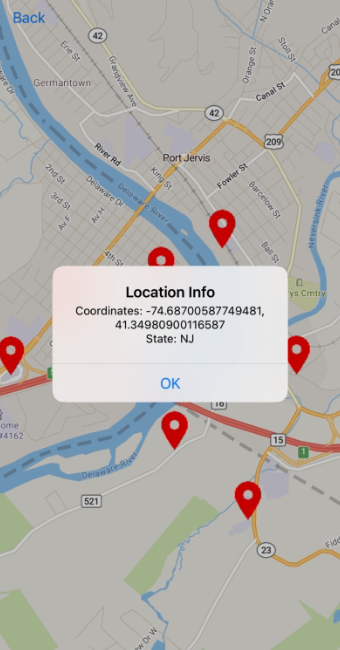Clickable Points
Contents
In this example, icons are displayed at the locations obtained from the JSON file, and when tapped on, custom data is displayed.

Sample Code
import Foundation
import UIKit
import MapKit
import TrimbleMaps
import TrimbleMapsAccounts
class ClickablePointsViewController: UIViewController, AccountManagerDelegate, TMGLMapViewDelegate {
internal var mapView: TMGLMapView!
private let SOURCE_ID = "tristatepoints"
private let LAYER_ID = "tristatepoints"
private let ICON_ID = "ic_location"
override func viewDidLoad() {
super.viewDidLoad()
let apiKey = "Your-API-key-here"
let account = Account(apiKey: apiKey, region: Region.northAmerica)
AccountManager.default.account = account
AccountManager.default.delegate = self
navigationItem.leftBarButtonItem = UIBarButtonItem(title: "Back", style: .plain, target: self, action: #selector(backButtonPressed))
}
func stateChanged(newStatus: AccountManagerState) {
if newStatus == .loaded {
DispatchQueue.main.async {
// Create a map view
self.mapView = TMGLMapView(frame: self.view.bounds)
self.mapView.delegate = self
// Set the map location
let center = CLLocationCoordinate2D(latitude: 41.36290180612575, longitude: -74.6946761628674)
self.mapView.setCenter(center, zoomLevel: 13, animated: false)
// Add the map
self.view.addSubview(self.mapView)
}
}
}
func mapViewDidFinishLoadingMap(_ mapView: TMGLMapView) {
// In this example a .json file is being used as the source
let filePath = Bundle.main.path(forResource: "tristate", ofType: "json")!
let fileUrl = URL(fileURLWithPath: filePath)
// Create a source and add it to the style. Important to note, sources are linked to styles.
// If you change the style you may need to re-add your source and layers
let shapeSource = TMGLShapeSource(identifier: SOURCE_ID, url: fileUrl, options: .none)
mapView.style?.addSource(shapeSource)
// Add the icon image to the style
if let image = UIImage(named: ICON_ID) {
mapView.style?.setImage(image, forName: ICON_ID)
}
// Create a SymbolLayer to display the icons
let symbolLayer = TMGLSymbolStyleLayer(identifier: LAYER_ID, source: shapeSource)
symbolLayer.iconImageName = NSExpression(forConstantValue: ICON_ID)
// Add the layer
mapView.style?.addLayer(symbolLayer)
// Add tap gesture recognizer
let tapGestureRecognizer = UITapGestureRecognizer(target: self, action: #selector(handleMapTap(_:)))
mapView.addGestureRecognizer(tapGestureRecognizer)
}
@objc func handleMapTap(_ sender: UITapGestureRecognizer) {
// Get the point where the user tapped on the map and convert it to map coordinates
let point = sender.location(in: mapView)
let coordinate = mapView.convert(point, toCoordinateFrom: mapView)
// Get the features visible at the tapped point, check if the first feature is a TMGLPointFeature, and show an alert with its coordinates and state
let features = mapView.visibleFeatures(at: point, styleLayerIdentifiers: Set([LAYER_ID]))
if let feature = features.first as? TMGLPointFeature, let properties = feature.attributes as? [String: Any] {
let state = properties["state"] as? String ?? "Unknown"
let coordinates = feature.coordinate
let message = "Coordinates: \(coordinates.longitude), \(coordinates.latitude)\nState: \(state)"
showAlert(message: message)
}
}
func showAlert(message: String) {
// Displays the message
let alert = UIAlertController(title: "Location Info", message: message, preferredStyle: .alert)
alert.addAction(UIAlertAction(title: "OK", style: .default, handler: nil))
present(alert, animated: true, completion: nil)
}
@objc func backButtonPressed() {
dismiss(animated: true, completion: nil)
}
}